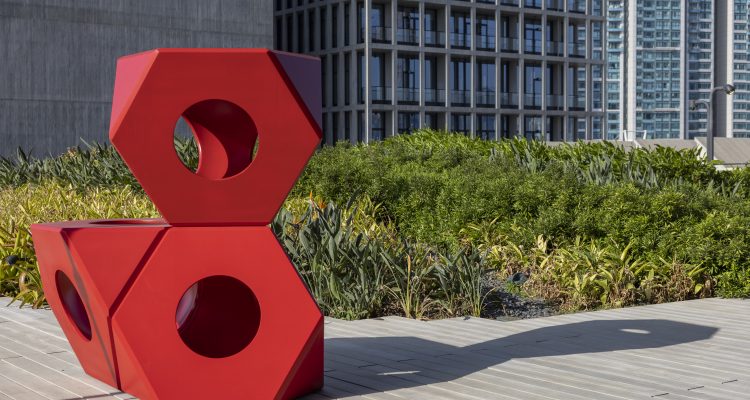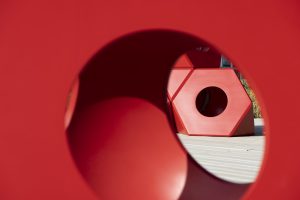As part of the M+ Playscape, the Octetras are among the few pieces of art at the M+ Museum in Hong Kong that visitorsare encouraged to touch. The recreations of Japanese American sculptor Isamu Noguchi’s sculptures sit in assemblies across a rooftop garden at the museum for contemporary visual culture, which opened in 2021.
Like the initial Octetras, which were designed to be stacked in multiple configurations for use in playgrounds and public plazas, these sculptures are arranged to stimulate play and make connections between the body and imagination, explains Doryun Chong, M+ Museum’s deputy director and chief curator. Unlike Noguchi’s cast concrete Octetra sculptures, which each weigh approximately 2,400 pounds, the sculptures at the M+ Museum are light enough for rooftop use. GFRP provided the weight savings the museum needed – and a connection to the artist’s initial vision.
Noguchi made early versions of these pieces in fiberglass in the 1960s but didn’t pursue the material for public art installations “largely due to the state-of-the-art at that point in the composites industry,” explains Alfred Lippincott, co-owner of Lippincott’s, LLC. Returning to Noguchi’s original material of choice for the museum project created a meaningful connection between the artist and this sculptural reproduction.
For decades, North Haven, Conn.-based Lippincott’s has provided artists and museums with fabrication solutions for large-scale sculptures. M+ Museum reached out to the contractor to recreate a series of Octetra for a rooftop installation. Each vibrant red piece is made up of five triangular pyramids and stands approximately 3½ feet tall. They are intended to be stacked in groups.
“When you look at the piece closely, you see that each corner is multifaceted. It’s not just one edge – there are three or four edges and then they come to a point,” says Tom Krivickas, president of CT Composites Inc. in South Windsor, Conn. “All of those edges line up when you put the pieces together, no matter what direction they’re arranged. It is crucial to have them line up so you don’t see any light underneath it or any gaps.”
Lippincott’s contacted CT Composites to fabricate the sculptures once the contractor selected composite materials rather than aluminum for the project. Creating this complex shape in aluminum would have required extrusion of more than 50 pieces of varying shapes, as well as jigs to hold the parts while the adhesive cured.
“Every time you added another piece, it would have complicated the project even more,” says Krivickas. Moving to GFRP meant each Octetra sculpture could be assembled using only nine pieces.
This simplification helped streamline production. More significantly, using GFRP lowered the sculpture’s weight to 185 pounds compared to more than 300 pounds for aluminum.
“As is the case with most fabrication, a lot of thought goes into how best to do the mold,” Lippincott says. “First, we had to think about how to break the piece apart to make a collapsible sphere mold that would allow us to make the sculpture’s spherical interior.” The mold needed to collapse so it would fit through the four round openings at the edges of the sphere.
Lippincott’s provided CT Composites with the collapsable mold and CAD drawings with the required dimensions to machine a precise plug and, from that, build additional molds for the remaining pieces of the sculpture.
CT Composites used hand lay-up to fabricate the first Octetra sculpture, then made subsequent ones via vacuum infusion. This switch streamlined the process, delivered a more exacting piece and reduced overall fabrication costs for the 11 Octetra pieces ultimately delivered to the museum.
The only material requirement was that the final structure had to be fire retardant. To accomplish this, CT Composites used a polyester resin from Polynt Group, reinforced by Chomarat ROVICORE™ fiberglass mats and Vectorply fabrics. Krivickas notes that the material choices were driven by the need to balance cosmetics, strength and weight, as well as mimic the feel of the original concrete Octetra.
“We wanted to make it so that if somebody tapped on it or tried to move it, it felt as heavy as concrete,” he explains. “We did that with the coring and how we laid the material up.” The core is made from Gurit® Corecell™ M, a high-performance foam.
Pieces of the sculpture are secured to one another with magnetic latches to prevent stacked Octetras from tipping while children climb on or through the shapes. Lippincott’s devised the latch assemblies, with mounting points hidden inside drainage tubes.
The lightweight GFRP pieces also simplified installation. Workers had to tip the shapes over to bolt them together, which would not have been possible with concrete shapes. “It’s an odd shape, but two people can pick one up and move it, unlike the concrete one,” says Krivickas.
Megan Headley is a freelance writer in Fredericksburg, Va. She can be reached at megan@clearstorypublications.com.
The GFRP Octetra sculptures are fabricated so that sides align seamlessly when the shapes are installed as a series.
Photo Credit: Lok Cheng, courtesy of M+, Hong Kong



